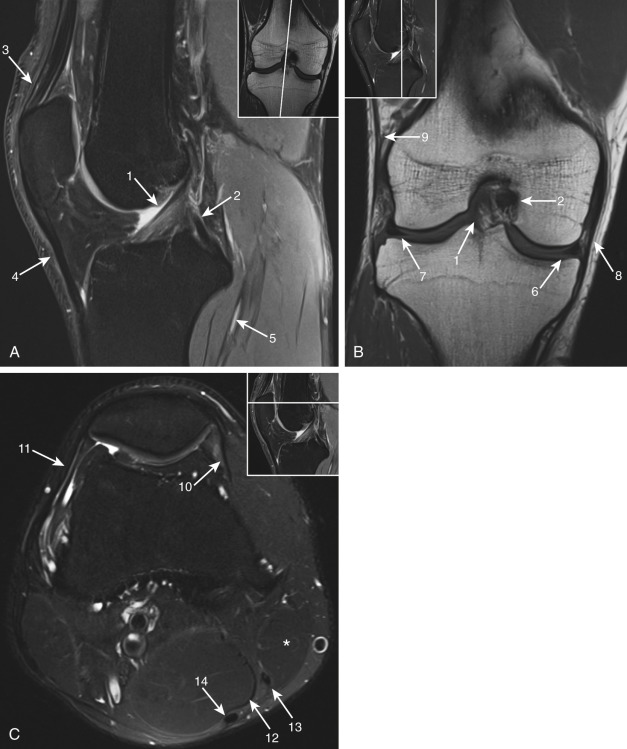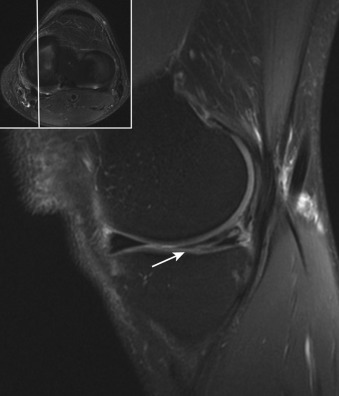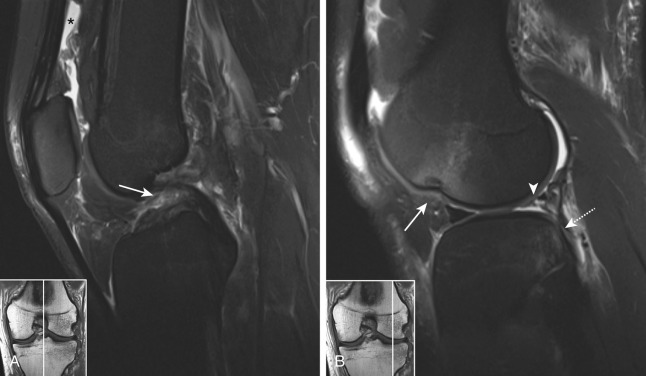Physical Address
304 North Cardinal St.
Dorchester Center, MA 02124
Routine knee MRI typically includes:
Sagittal fat-suppressed proton density (PD)-weighted and fat-suppressed T2-weighted images.
Coronal T1-weighted and fat-suppressed T2-weighted images.
Axial fat-suppressed T2-weighted images.
Please see Figure 56-1 for some normal knee anatomy on MRI.

The clinical presentation of a meniscal tear is typically pain and locking of the knee. The posterior horn of the medial meniscus is the primary weight-bearing surface and is most commonly torn. The anterior horn of the lateral meniscus is the most common site for a false-positive diagnosis, where the normal anterior transverse meniscal ligament may mimic a tear.
The menisci are crescent-shaped structures within the joint at the medial and lateral aspects of the superior tibial articular surface. They are composed mainly of fibrocartilage and are low in signal intensity on all imaging sequences. On sagittal images, the menisci appear as bow tie–shaped structures. The posterior horn of the medial meniscus is larger than the anterior horn whereas the posterior and anterior horns of the lateral meniscus are similar in size.
A meniscal tear can be diagnosed using either of these two major criteria:
Abnormal meniscal morphology
Increased signal intensity within the meniscal tissue which extends to the articular surface on at least two contiguous slices
Horizontal or oblique tear is the most common type, frequently involving the posterior horn of the medial meniscus ( Figure 56-2 ). This is a degenerative type tear rather than a traumatic type tear.

Longitudinal tear is a vertically oriented tear that extends parallel to the circumference of the meniscus and is almost always associated with traumatic injury.
Radial tear occurs in vertical orientation perpendicular to the long axis of the meniscus. This is often seen as a cleft in the meniscus or with a truncated meniscal contour. If the tear is along the imaging plane, the absence of the meniscus on one image can be used to make the diagnosis (“ghost meniscus” sign) ( Figure 56-3 ). A radially torn medial meniscus will often extrude medially, extending beyond the margin of the tibial plateau by greater than 3 mm.

Complex tear is a tear that extends in more than one plane. This tear has extensive distortion of the meniscal substance and results in multiple flaps.
Bucket handle tear is a type of a longitudinal tear where the inner edge of the meniscus is displaced. This type of tear can be identified by noting absence of the inner margin of the bow tie as seen on sagittal images. The displaced fragment can lie anterior to the posterior cruciate ligament (PCL) (“double PCL” sign) or may have flipped anteriorly to abut the anterior meniscal horn (“double anterior horn” sign).
Displaced flap tear occurs when a fragment of the meniscus is displaced away from the site of tear. This most commonly occurs in the medial meniscus where the fragment is displaced into the medial gutter along the tibial plateau. The clinician should be alerted of this finding because it can be overlooked during arthroscopy if the surgeon fails to probe the medial gutter.
Meniscal root tear is a subtype of radial tear that occurs most frequently at the posterior medial meniscal root. This tear cannot resist hoop stress and often leads to complications such as meniscal extrusion, early secondary osteoarthritis, and subchondral insufficiency fracture.
A parameniscal cyst can form around the meniscus from extrusion of synovial fluid through a meniscal tear by one-way ball-valve mechanism. A cystic structure around or extending from the meniscus is a finding that is very closely associated with a meniscal tear, and so an underlying meniscal tear should be suspected even if not clearly identified.
Discoid meniscus is a common variant with morphologic enlargement of the meniscus. Patients usually present with clicking or locking of the knee. As acquired sagittal images can be variable in thickness from scan to scan, this diagnosis can best be made on coronal images. On a coronal MR image through the middle of the femoral condyle, a meniscus that extends centrally beyond the midpoint of the femoral condyle represents a discoid meniscus. The lateral meniscus is more commonly affected, and discoid menisci occur bilaterally in up to 25%.
Become a Clinical Tree membership for Full access and enjoy Unlimited articles
If you are a member. Log in here